Klipsch Heritage The Sevens with HDMI review
The Klipsch Heritage The Sevens are designed to fill a gap. And may make some people think extensively when adding a mature sound solution to their TV: would it be better to add a chunky soundbar plus subwoofer or rather go for a pair of active bookshelf speakers offering HDMI? So far, you would be always ending up with a compromise in terms of sound quality. Klipsch´s The Fives may have been making this concept popular, but would not satisfy everyone´s demands in terms of bass capabilities.
So, Klipsch ended up in pushing the ´´ stereo speakers plus TV´ formula to a new level. Their ´Heritage Wireless´ line of active speakers recently was seeing some more sophisticated additions: on one hand a set called The Nines meant to master rather large rooms, plus the reasonably sized bookshelf mod named The Sevens. Bass/mid driver, hornloaded tweeter, cabinet size and amplifier power have all grown significantly so we would consider this all-in-one-system to be a mature stereo solution. The workmanship got improved as well as our review sample in walnut real wood veneer was really accurately manufactured.
So – is it really possible that buying just a pair of active speakers getting you a versatile all-in-one system outperforming soundbar or sub/sat combination even in terms of bass?
From HDMI to phono input – we love the concept!
Offering Bluetooth, HDMI (ARC) plus phono input alongside USB, analogue and optical inputs, that is pretty much everything you may ever want if you are not going for streaming devices. Operating this ´buint-in-the-box´ system is as easy and intuitive as it gets: you find two dial selectors in high-quality metal being seemlessly integrated into the master box enabling really everyone to control volume and source selection.
HDMI in on the back means HDMI(ARC) which is solely being connected to and controlled by a TV set. So it´s a perfect solution for family members being familiar being not into Hi-Fi or streaming but solely interested in enjoying nice sound when switching on the TV. Others might want to switch to on of the remaing five sources which can also be achieved by using the remote control or Klipsch´s designated app.
Analogue audio welcome
Analogue sources can be plugged in via 3.5 mm jack or RCA. The latter can either serve as a line level input or be converted into a phonopre (solely MM level). Turntables without built-in preamp can thereby be connected properly as an additional GND screw is integrated to avoid ground loops and resulting humming problems. However, it is not the most audiophile phono amp, but it is working flawlessly.
However, a full-fledged HiRes DAC is available for digital sources. It can handle PCM streams of up to 192kHz/24bit resolution. To ensure maximum resolution, it is advisable to connect a PC or Mac to the USB-B input. Outdated TV sets, streaming hubs or CD players in most cases offer an optical Toslink which is also included.
When getting the Sevens out of the box we especially liked that the fact that the necessary wires both for HDMI and USB-B are included.
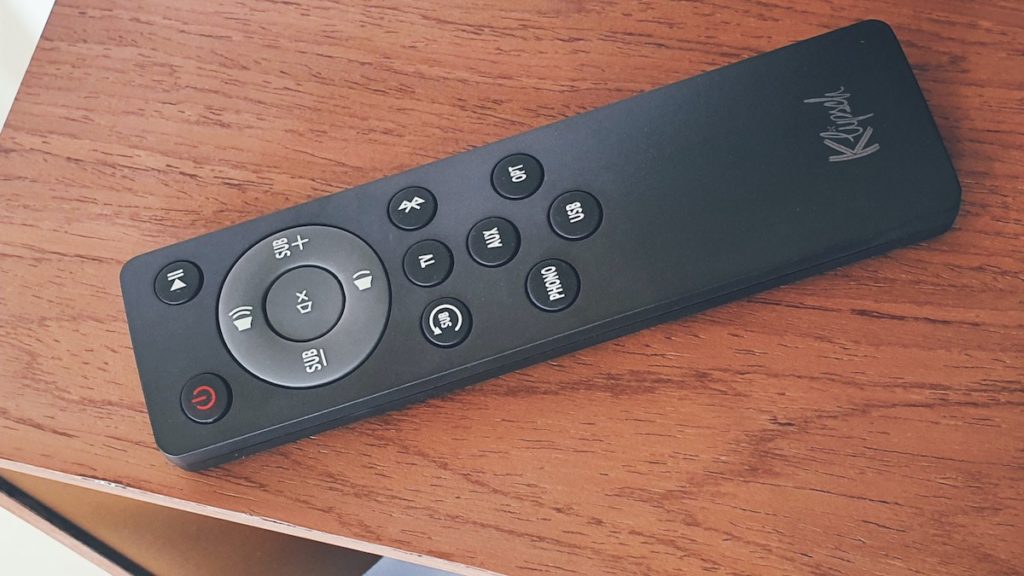
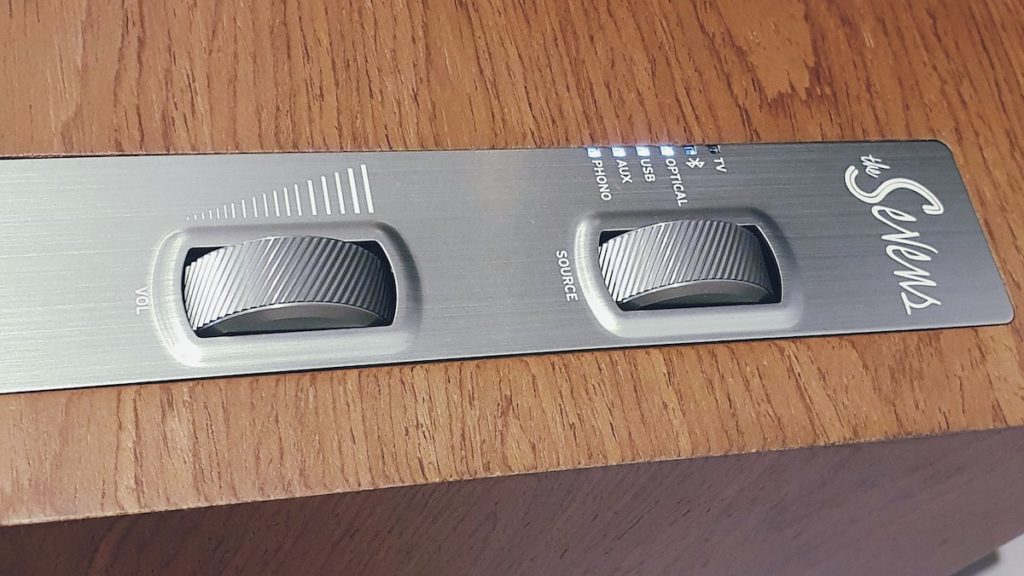
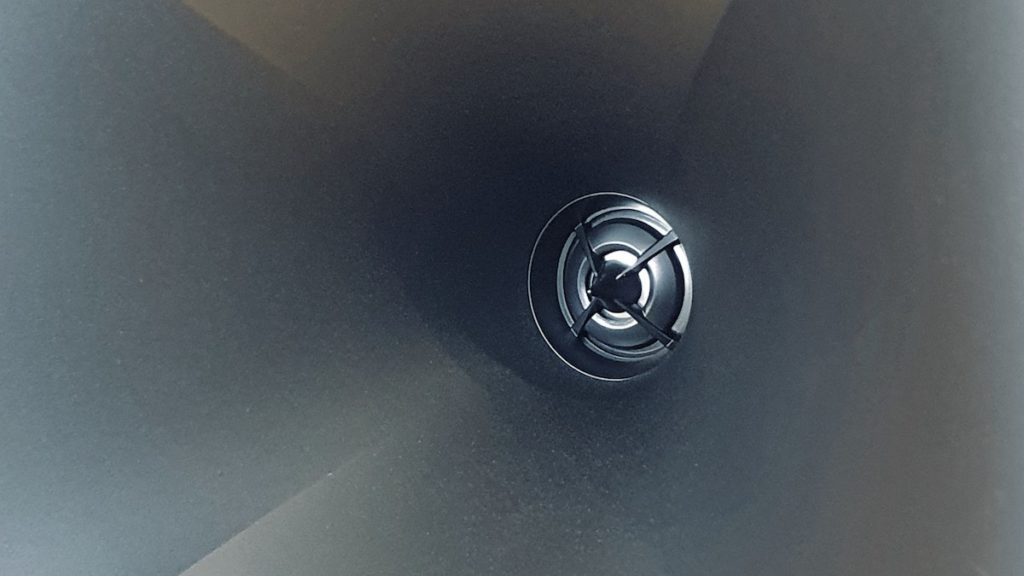
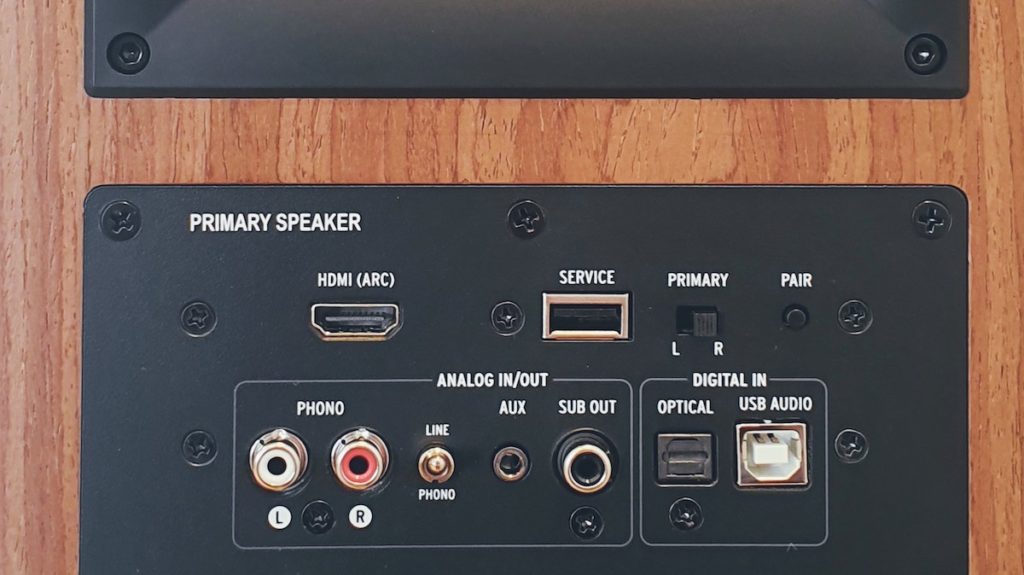
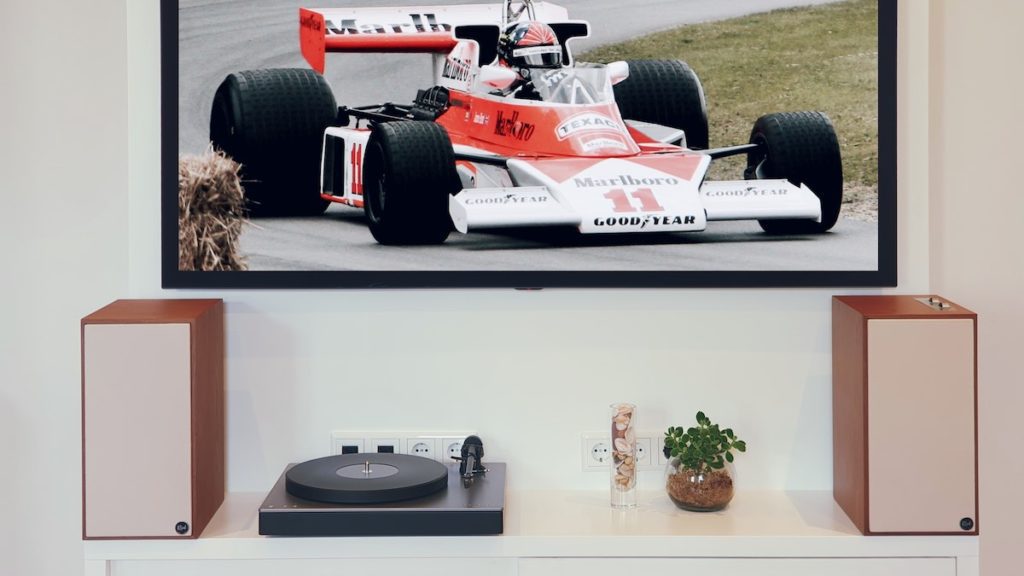
Bluetooth 5.0 playback is the sixth option. Besides the SBC standard codec (being pretty much limited in terms of quality), both AAC and Apt-X HD ensure true Hi-Fi quality.
Fourfold power built in
The 6.5″ bass driver is offering a diaphragm made of stiff cellulose boasting with its impressively large surround. In terms of cabinet size, The Sevens are rather on the larger end of what we would call a bookshelf speaker. But as they are rather slim in width they absolutely do not look chunky despite from offering a maximum of diaphragm area with their 6.5″ bass driver being supported by a rectangular vent on the back.
There is enough of power to achieve stunning dynamics: Four channels of power amps in the master speaker. This said, to more powerful amps are driving both bass drivers of a stereo pair plus two less powerful ones for the hornloaded tweeters needing just a fraction of input power thanks to their high efficiency. Such a fully active x-over system has one downside: The slave speaker must be connected with a proprietary four-core wire, as it separated signals for both woofer and tweeter are necessary. A typical issue with such concept is the fixed length of the connecting wire. Klipsch offers a solution of a 4-meter wire being included plus on optional 2-meters extension both being included in the package. Which speaker marks left and right channel can be easily selected as some might want to have PC or TV connections rather on the left or the right speaker.
Klipsch’s very own technology: The Tractrix Horn
Hornloaded tweeters are a thing Klipsch is very-well known for as the Klipschorn, built continuously since 1946, is a true classic Hi-Fi history. The Seven´s horn tweeter, although, seems to be a rather modern one. Klipsch calls this Tractrix pointing out that the waveguide´s shape creates a perfectly harmonious transition between the rounded compression driver and the rectangular output area. The horn is specified as offering a pretty decent sweet spot of 90 x 90 degrees which allowse you to place several listeners next to each other on a huge sofa without being afraid that tonal balancing might be spoiled for some of them.
On the other hand, speaking in terms of room acoustics and reverberation, it achieves a comparably narrower directivity pattern compared to most of compact active speakers. A certain degree of focussing the sound pressure on the sweet spot is especially desirable and useful when listeners are placed some meters away from the speakers or the room is showing a tendency towards underdamping (which pretty much every modern living room is).
This app is fast, but not perfect
The Klipsch Connect app (for iOS or Android) basically controls all the Heritage Sevens´ features. Once a Bluetooth connection is established as an additional Wifi or network connection is not necessary. In practice, the setup via app worked surprisingly smoothly with both Android devices and iPhones. Only annoying thing we noticed: when playing music via Bluetooth continuously, the app might sometimes lose contact. So, if you want to use the app as a primary remote control, you might want to make sure you stop the Bluetooth stream first.
However, the app´s capability goes far beyond replacing an RC. We really liked some of the settings being exclusively available via app. For example, the bass level can be adjusted in 3 steps depending on where the speakers are positioned: Free-on-a-stand, close to the wall or in a corner.
Individual sound-tuning via app
An additional 3-band graphic EQ provides sonic fine tuning. This is especially important in rooms with unusually strong or non-existent damping as the characteristic sound of a focussing horn might require a tiny adjustment of trebles in order not to sound either dull or harsh.
Further options include a loudness-style bass boost (which, however, we rather be sounding too fat in most rooms), a night mode offering a bass limiter and a subwoofer x-over mode. Adjusting the subwoofer level, by the way, this also offered on the remote control which is a really cool feature.
If both RC and smartphone are not at hand, you can simply go to the master box’s wheels and adjust both volume and source selection manually. Visual feedback is provided by a row of LEDs. That´s what we call a really intuitive concept!
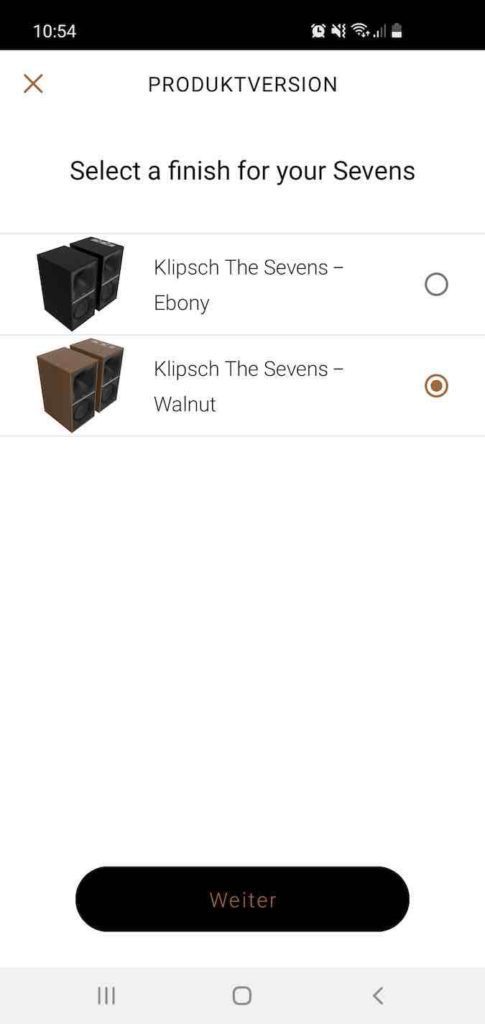
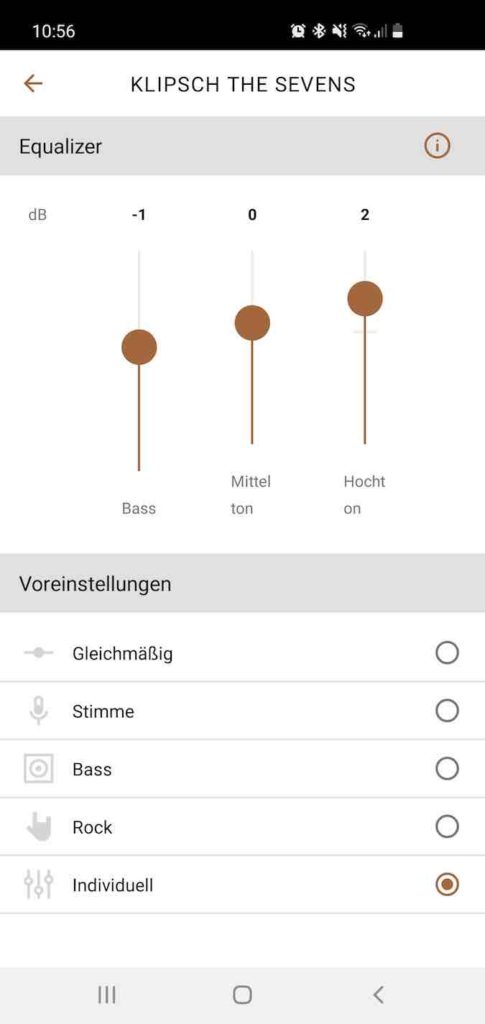
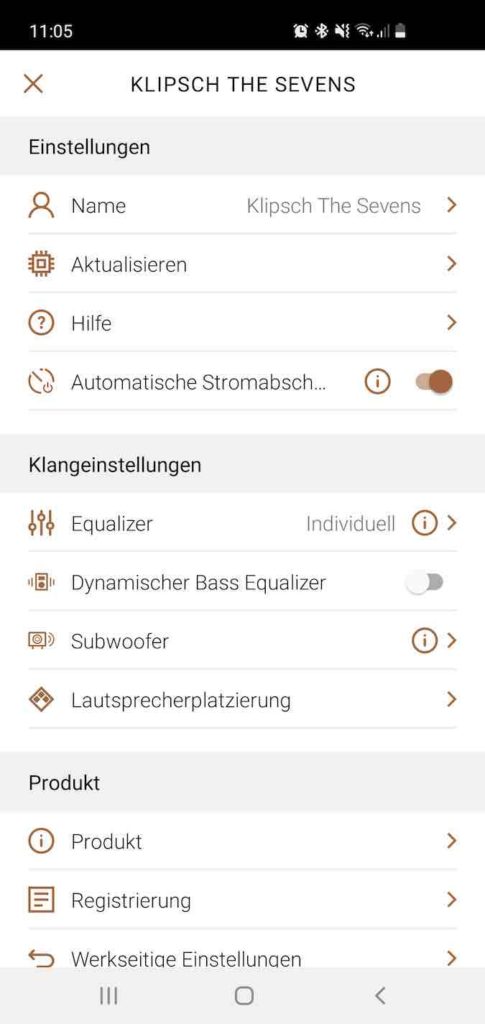
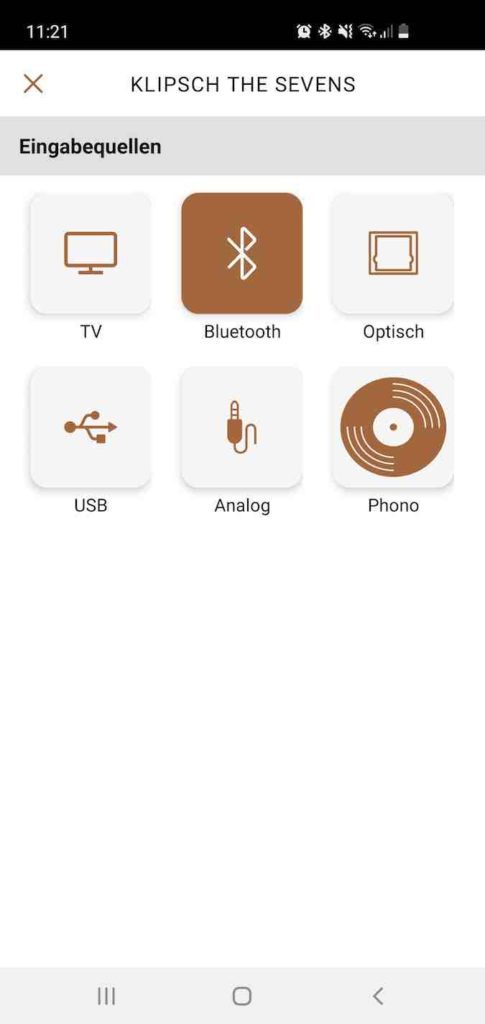
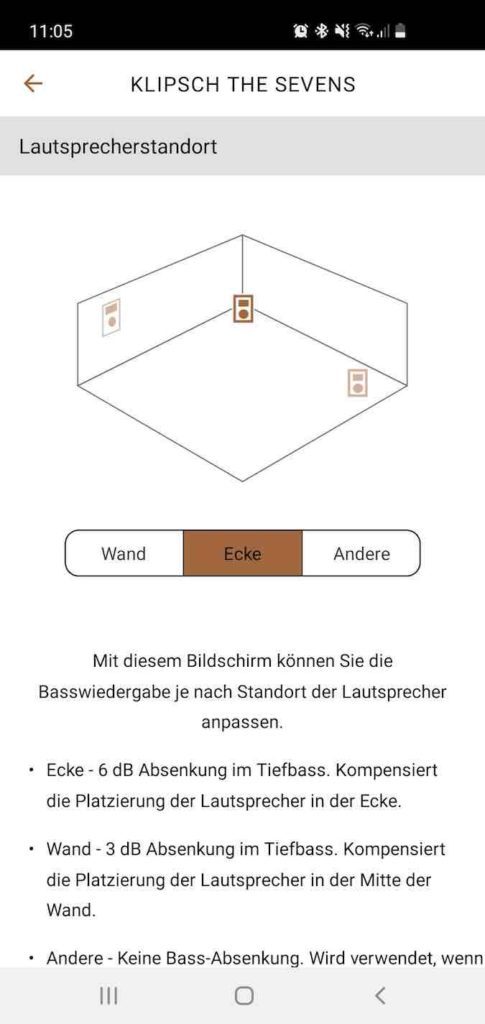
Sound quality estimation of Klipsch´s Heritage The Sevens
Those who expect any hornloaded bookshelf speaker to sound as rough, direct and PA-like as Mackie’s little “Thump Go 8” did, might be in for a surprise. Yes, the Klipsch Sevens offers a stunning level of subjective dynamics and it is pretty impulsive. When listening to Pink Floyd’s “The Wall” we had the feeling as if we were listening to a pair of floorstanding speakers rather than two slim bookshelf models. Every drum impulse came pretty directly and with an astonishing level of energy.
But unlike a portable sound reinforcement system, Klipsch´s The Sevens tonyl balance was pretty much on the neat and warm side. Its treble we would call unobtrusive if not mild reminding us somehow of a jazz club with dimmed light rather than a strobe-filled hammering techno club. If that doesn’t give you enough energy and treble brightness, you might want to use the in-app EQ to add a bit of shine.
This might be still sounding a bit too soft for ecstatic party music, but connected to a TV we found the hornloaded speaker to be doing their job all the better for it. The bass is reaching surprisingly deep and brings a fat, rich foundation to bass drum and movie´s special FX hits, but its timing keeps up well with the mids and treble. If you place both your Sevens directly against the wall, the bass might be a bit overly fat but this can be easily corrected by choosing the placement in the app accordingly. That´s pretty good, but not quite perfect, as especially smaller rooms seem to add a certain persisting oversaturation to the low bass.
If you try to have the Sevens set up properly, you might want to rule out smaller rooms and near field listening anyway. That´s not what they are meant for and their rather large staging really requires an accordingly large stereo triangle.
Klipsch Heritage The Sevens: A true alternative to any soundbar?
We were particularly impressed by speech intelligibility and the width of the stage even when trying surprisingly huge listening distances. Even when speakers being placed in the corners of our room and the listener sitting on the opposite side, voices remained perfectly stable offering maximum clarity as if we were using a center speaker. In any case, we did not miss a center or surround speakers for movie enjoyment, nor did we miss a subwoofer. Surely, surround and Atmos FX are absent, but the wide ambience makes up for it in most movies and concert videos.
No matter which genre from hip-hop, rock, pop, electronic tracks to big-band jazz we were listening to when exploring Klipsch´s Sevens, the result was always dynamic, never fatiguing, pretty mature and cultivated entertainment. They handled demanding voices pretty well, even if individual singers perhaps sounded a bit squeezed than some audiophiles might expect. We only didn’t really warm up to classical music; strings and huge choirs were definitely lacking a bit of transparency and spatial depth. And the phono input sounded balanced, but also slowed down the music in terms of dynamics and treble resolution.
The Sevens or other active speakers?
The concept of having an app-controlled stereo system offering six sources including HDMI and phono input buint in a pair of stereo speakers is as successful as it is unique. Some competitors might deliver extra treble brilliance and resolution when listening in near-field conditions, but Klipsch´s Sevens are most likely to outperform every single one in terms of dynamics and imaging as soon as the acoustical environment becomes more challenging. For large or sparsely furnished rooms, we don’t know of any serious alternative among compact active speakers, even more expensive ones.
On the other hand,as mentioned, tweeters and their direct character are not ideal for near field. A set of Mission LX Connect might provide more of homogeneity and a more convincing ambience when used primarily as a desktop speaker.
Specifications Klipsch Heritage The Sevens
- Retail price: 1600 dollars/pounds/euros
- Dimensions (W x H x D): 21 x 41.5 x 27.5 cm
- Weight: 10.1 kg (master box)
- Features: HDMI-ARC, Bluetooth 5.0, USB-B, phono/line and AUX input, optical digital input, sub-out, app control, position EQ, connection cable 4 m + 2 m included.
- More at: klipsch.com
Der Beitrag Klipsch Heritage The Sevens with HDMI review erschien zuerst auf stereoguide.com.
stereoguide-referencehometheater-techradar